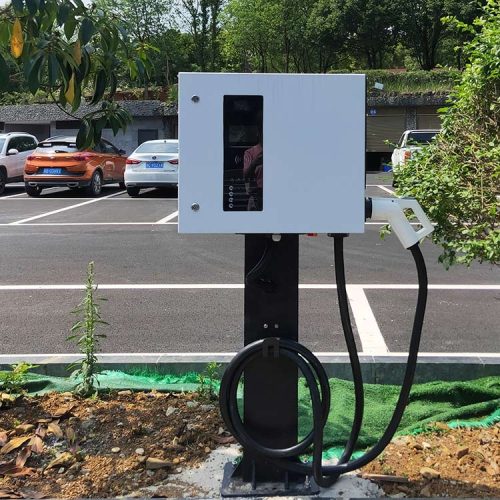Steps of installing electric vehicle charging station at home
The process of installing electric vehicle charging station at home:
Installing electric vehicle charging station at home may be a wonderful way to cut costs, lessen your carbon footprint, and avoid long queues at public charging stations. We will lead you through the process of setting up a home charging station for electric vehicles in this tutorial.
Step 1: Determine the Type of Charging Station
Choosing the right sort of charging station is the first step in installing an EV charging station at home. Three different types of EV charging stations exist:
- Level 1 Charging:
This sort of charging station uses a typical 120-volt plug and is the slowest type available. Low-mileage drivers and those who have plenty of time to charge their EVs should choose level 1 charging.
- Level 2 Charging:
This sort of EV charging station is the most prevalent and uses a 240-volt outlet. Depending on the battery’s size and the station’s power output, level 2 charging can fully charge your EV in a few hours.
- DC Fast Charging:
This sort of charging station employs a powerful DC connection and is the quickest available. Your EV may be charged to 80% using DC fast charging in less than 30 minutes.
The majority of EVs come with a Level 1 charging connection; however, installing a Level 2 charging station will allow you to charge your EV more quickly. Installing a DC fast charging station may also be something you want to think about if you routinely take lengthy vacations or have a long commute.

Step 2: Decide Where to Place Your Charging Station
The location of your charging station is the next stage in establishing an Eelectric Vvehicle charging station at home. Ideally, it would help if you put your charging station close to where you park your electric vehicle (EV) and in an area that is both accessible and convenient. Additionally, you should confirm that the location is close to your electrical panel and has access to electricity. You should also consider the charging cord’s length when deciding where to put your charging station. The charging cable has to be long enough to reach the charging port on your electric vehicle (EV) without placing undue strain on the cable.
Step 3: Hire an electrician
You’ll need to contact a certified electrician to installing electric vehicle charging station at home because it involves electrical work. In order to construct a dedicated circuit for your charging station, your electrician will likely need to upgrade your electrical system. In order to safeguard against electrical shock, your electrician will also need to install a ground fault circuit interrupter (GFCI). Your electrician might also need to install a new circuit breaker and wiring, depending on the kind of charging station you select.
Step 4: Place the charging station
It’s time to install the charging station after your electrician has completed the dedicated circuit and wiring. Most EV charging stations have mounting hardware, so you’ll need to place the station somewhere solid, like a wall or a post. Connecting the charging station’s cables to the designated circuit must be done before mounting the charging station. To do this, normally, the access panel of the charging station is opened, and the wires are attached to the proper terminals.
Step 5: Test the charging station
Your electrician must test the charging station to ensure it is operating properly after installation. Ensuring the charging station provides the appropriate amount of electricity usually entails plugging in an EV and verifying the voltage and amperage levels. Additionally, your electrician will check the connections at the charging station to ensure they are tight and secure and test the GFCI to ensure it functions properly.
Step 6: Enjoy Your New EV Charging Station
Congratulations! Your home’s EV charging station was successfully installed. Thanks to your new charging station, you can now rapidly charge your electric vehicle at home. Connect your electric vehicle (EV) to the charging station using the charging cable that came with it. Verify that the cable is not kinked or broken and that the charging station is secured securely. The majority of EVs include a built-in feature that lets you control the charging schedule and track the development of the charge from your smartphone. You may use this function to streamline your charging routine and steer clear of peak power prices.
- To be sure you’re charging your EV safely and correctly, go to the owner handbook for your car or contact the manufacturer. Keep in mind that various EVs have varied charging requirements.
- Keeping your charging station clean and clear of debris is also a good idea because it may help the station last longer and avoid any safety issues.
- Take pleasure in the comfort and savings that come with charging your EV at home, and take satisfaction in knowing that you’re contributing to emissions reduction and environmental protection.
Conclusion:
Installing electric vehicle charging station at home may be a terrific way to cut costs, lessen your environmental impact, and improve your quality of life. You can maximize the use of your electric vehicle (EV) and ensure you’re always prepared to go on the road with the proper configuration and charger.
Customers of KINOUWELL have access to the newest, best, most original, and most secure items. Our top priority is making you happy. We promise you that we’ll give you only the greatest products and services and keep our word. Given that we are constantly there to serve your needs, you may rely on us repeatedly. Therefore, benefit from Kinouwell savings on top-notch gear. Knowing that we will be a top selection will allow you to relax.

